tire pressure reset NISSAN LEAF 2017 1.G Owners Manual
[x] Cancel search | Manufacturer: NISSAN, Model Year: 2017, Model line: LEAF, Model: NISSAN LEAF 2017 1.GPages: 424, PDF Size: 4.51 MB
Page 157 of 424
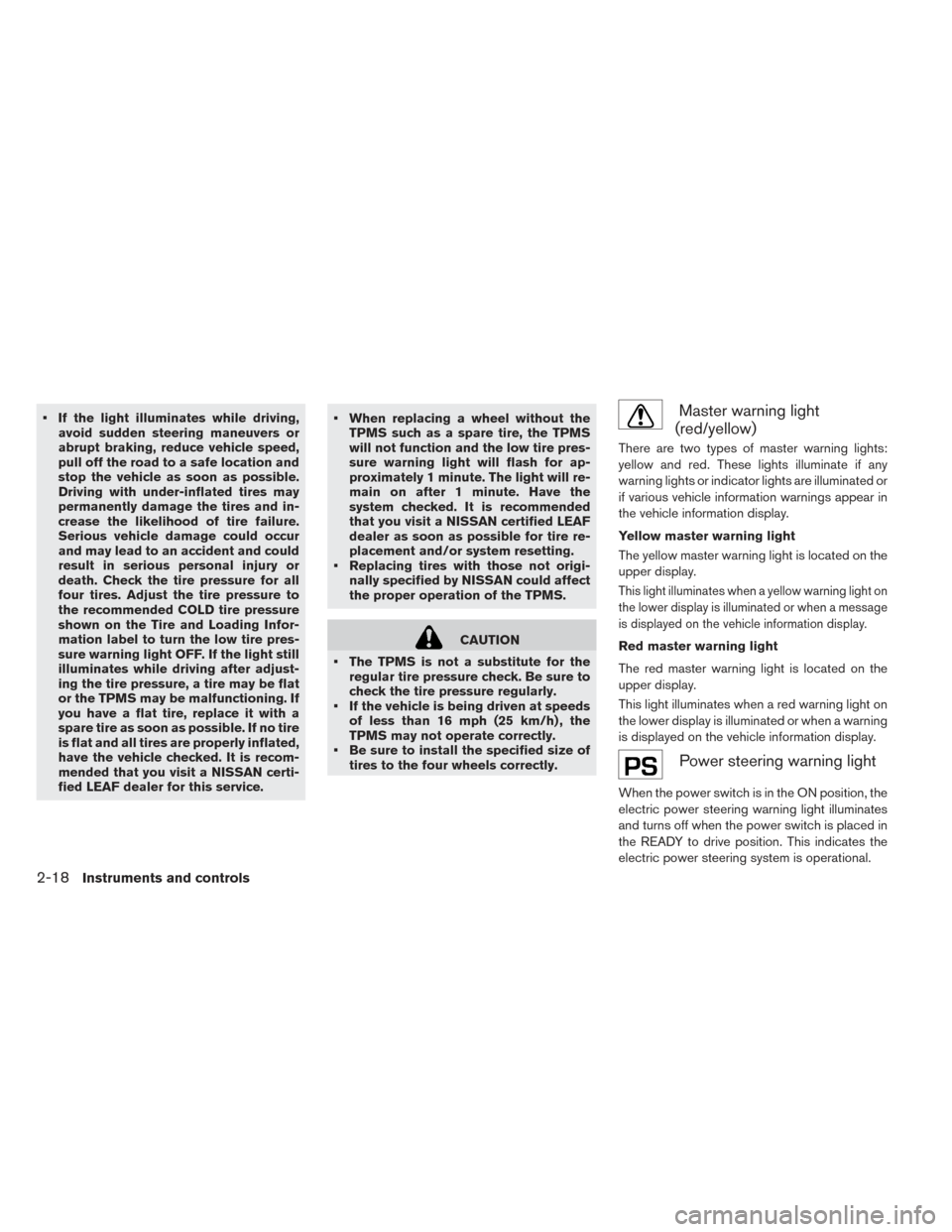
• If the light illuminates while driving,avoid sudden steering maneuvers or
abrupt braking, reduce vehicle speed,
pull off the road to a safe location and
stop the vehicle as soon as possible.
Driving with under-inflated tires may
permanently damage the tires and in-
crease the likelihood of tire failure.
Serious vehicle damage could occur
and may lead to an accident and could
result in serious personal injury or
death. Check the tire pressure for all
four tires. Adjust the tire pressure to
the recommended COLD tire pressure
shown on the Tire and Loading Infor-
mation label to turn the low tire pres-
sure warning light OFF. If the light still
illuminates while driving after adjust-
ing the tire pressure, a tire may be flat
or the TPMS may be malfunctioning. If
you have a flat tire, replace it with a
spare tire as soon as possible. If no tire
is flat and all tires are properly inflated,
have the vehicle checked. It is recom-
mended that you visit a NISSAN certi-
fied LEAF dealer for this service. • When replacing a wheel without the
TPMS such as a spare tire, the TPMS
will not function and the low tire pres-
sure warning light will flash for ap-
proximately 1 minute. The light will re-
main on after 1 minute. Have the
system checked. It is recommended
that you visit a NISSAN certified LEAF
dealer as soon as possible for tire re-
placement and/or system resetting.
• Replacing tires with those not origi- nally specified by NISSAN could affect
the proper operation of the TPMS.
CAUTION
• The TPMS is not a substitute for the regular tire pressure check. Be sure to
check the tire pressure regularly.
• If the vehicle is being driven at speeds of less than 16 mph (25 km/h) , the
TPMS may not operate correctly.
• Be sure to install the specified size of tires to the four wheels correctly.
Master warning light
(red/yellow)
There are two types of master warning lights:
yellow and red. These lights illuminate if any
warning lights or indicator lights are illuminated or
if various vehicle information warnings appear in
the vehicle information display.
Yellow master warning light
The yellow master warning light is located on the
upper display.
This light illuminates when a yellow warning light on
the lower display is illuminated or when a message
is displayed on the vehicle information display.
Red master warning light
The red master warning light is located on the
upper display.
This light illuminates when a red warning light on
the lower display is illuminated or when a warning
is displayed on the vehicle information display.
Power steering warning light
When the power switch is in the ON position, the
electric power steering warning light illuminates
and turns off when the power switch is placed in
the READY to drive position. This indicates the
electric power steering system is operational.
2-18Instruments and controls
Page 174 of 424
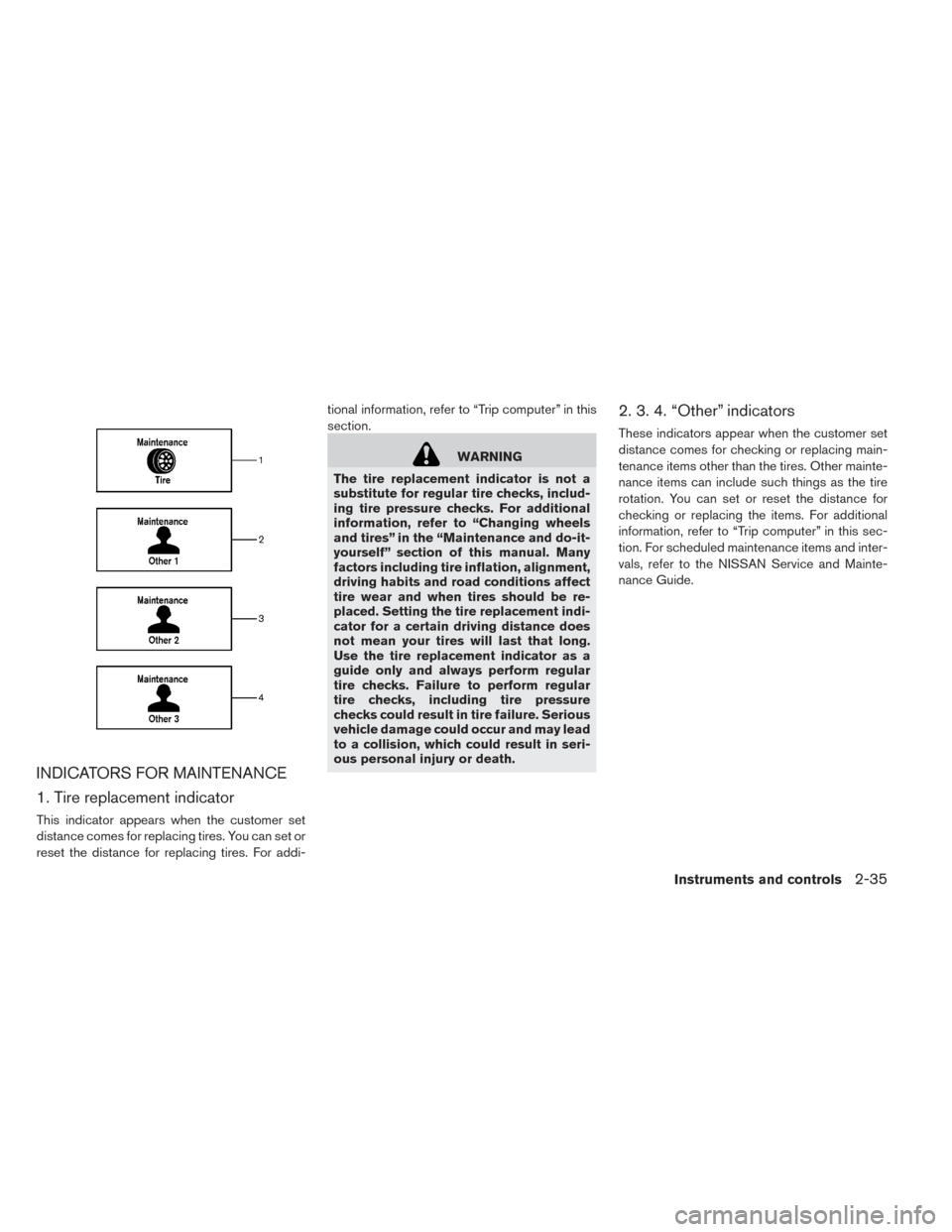
INDICATORS FOR MAINTENANCE
1. Tire replacement indicator
This indicator appears when the customer set
distance comes for replacing tires. You can set or
reset the distance for replacing tires. For addi-tional information, refer to “Trip computer” in this
section.
WARNING
The tire replacement indicator is not a
substitute for regular tire checks, includ-
ing tire pressure checks. For additional
information, refer to “Changing wheels
and tires” in the “Maintenance and do-it-
yourself” section of this manual. Many
factors including tire inflation, alignment,
driving habits and road conditions affect
tire wear and when tires should be re-
placed. Setting the tire replacement indi-
cator for a certain driving distance does
not mean your tires will last that long.
Use the tire replacement indicator as a
guide only and always perform regular
tire checks. Failure to perform regular
tire checks, including tire pressure
checks could result in tire failure. Serious
vehicle damage could occur and may lead
to a collision, which could result in seri-
ous personal injury or death.
2. 3. 4. “Other” indicators
These indicators appear when the customer set
distance comes for checking or replacing main-
tenance items other than the tires. Other mainte-
nance items can include such things as the tire
rotation. You can set or reset the distance for
checking or replacing the items. For additional
information, refer to “Trip computer” in this sec-
tion. For scheduled maintenance items and inter-
vals, refer to the NISSAN Service and Mainte-
nance Guide.
Instruments and controls2-35
Page 308 of 424
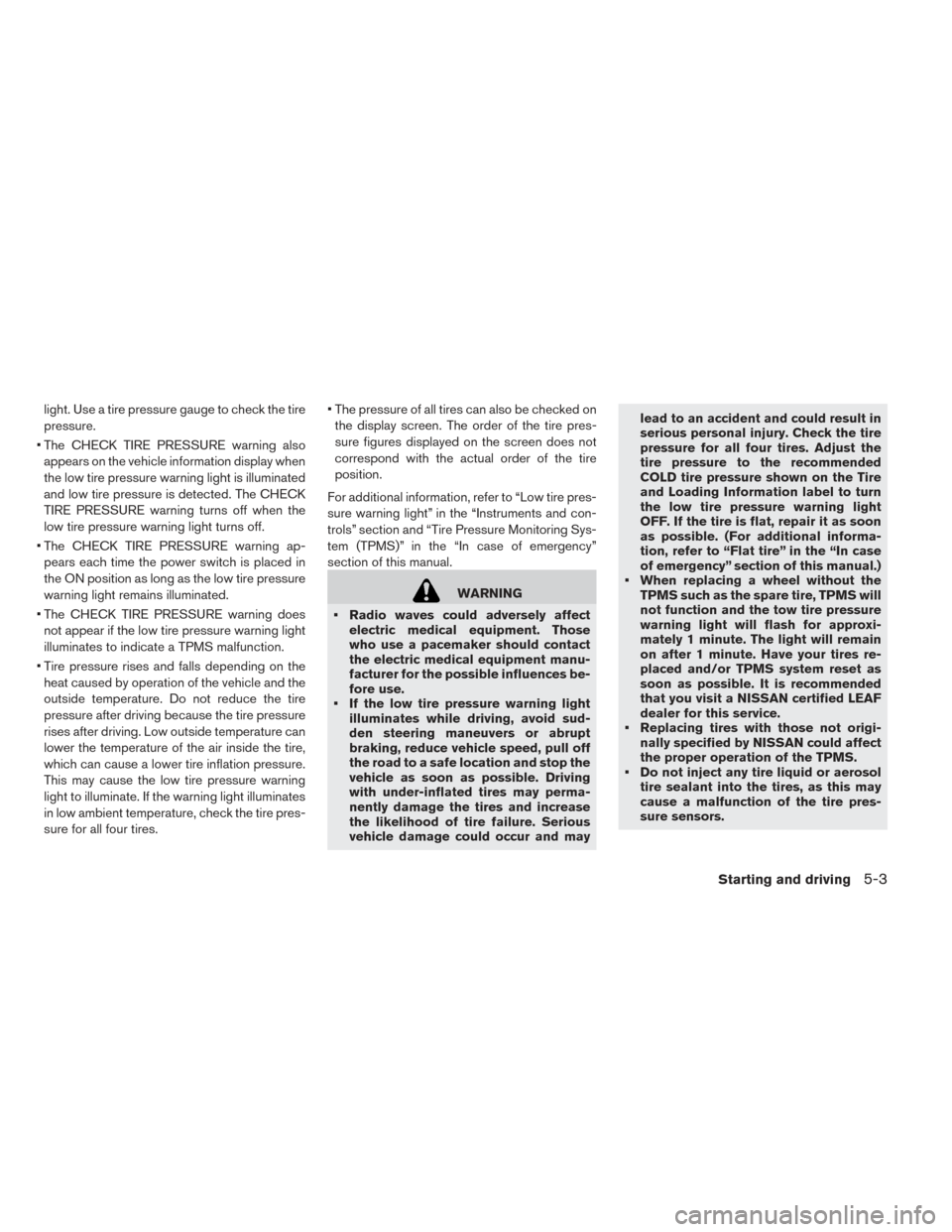
light. Use a tire pressure gauge to check the tire
pressure.
• The CHECK TIRE PRESSURE warning also appears on the vehicle information display when
the low tire pressure warning light is illuminated
and low tire pressure is detected. The CHECK
TIRE PRESSURE warning turns off when the
low tire pressure warning light turns off.
• The CHECK TIRE PRESSURE warning ap- pears each time the power switch is placed in
the ON position as long as the low tire pressure
warning light remains illuminated.
• The CHECK TIRE PRESSURE warning does not appear if the low tire pressure warning light
illuminates to indicate a TPMS malfunction.
• Tire pressure rises and falls depending on the heat caused by operation of the vehicle and the
outside temperature. Do not reduce the tire
pressure after driving because the tire pressure
rises after driving. Low outside temperature can
lower the temperature of the air inside the tire,
which can cause a lower tire inflation pressure.
This may cause the low tire pressure warning
light to illuminate. If the warning light illuminates
in low ambient temperature, check the tire pres-
sure for all four tires. • The pressure of all tires can also be checked on
the display screen. The order of the tire pres-
sure figures displayed on the screen does not
correspond with the actual order of the tire
position.
For additional information, refer to “Low tire pres-
sure warning light” in the “Instruments and con-
trols” section and “Tire Pressure Monitoring Sys-
tem (TPMS)” in the “In case of emergency”
section of this manual.
WARNING
• Radio waves could adversely affect electric medical equipment. Those
who use a pacemaker should contact
the electric medical equipment manu-
facturer for the possible influences be-
fore use.
• If the low tire pressure warning light illuminates while driving, avoid sud-
den steering maneuvers or abrupt
braking, reduce vehicle speed, pull off
the road to a safe location and stop the
vehicle as soon as possible. Driving
with under-inflated tires may perma-
nently damage the tires and increase
the likelihood of tire failure. Serious
vehicle damage could occur and may lead to an accident and could result in
serious personal injury. Check the tire
pressure for all four tires. Adjust the
tire pressure to the recommended
COLD tire pressure shown on the Tire
and Loading Information label to turn
the low tire pressure warning light
OFF. If the tire is flat, repair it as soon
as possible. (For additional informa-
tion, refer to “Flat tire” in the “In case
of emergency” section of this manual.)
• When replacing a wheel without the TPMS such as the spare tire, TPMS will
not function and the tow tire pressure
warning light will flash for approxi-
mately 1 minute. The light will remain
on after 1 minute. Have your tires re-
placed and/or TPMS system reset as
soon as possible. It is recommended
that you visit a NISSAN certified LEAF
dealer for this service.
• Replacing tires with those not origi- nally specified by NISSAN could affect
the proper operation of the TPMS.
• Do not inject any tire liquid or aerosol tire sealant into the tires, as this may
cause a malfunction of the tire pres-
sure sensors.
Starting and driving5-3
Page 323 of 424
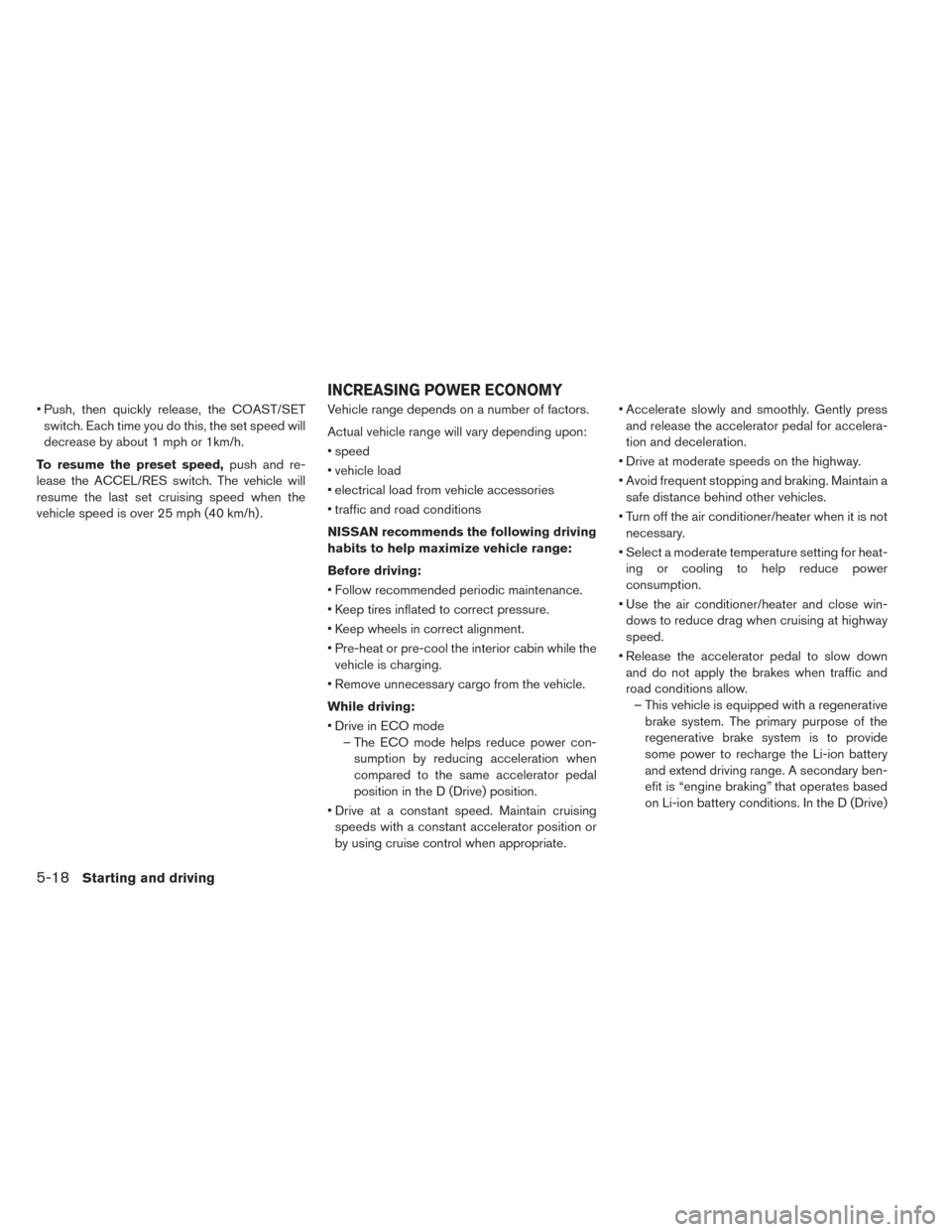
• Push, then quickly release, the COAST/SETswitch. Each time you do this, the set speed will
decrease by about 1 mph or 1km/h.
To resume the preset speed, push and re-
lease the ACCEL/RES switch. The vehicle will
resume the last set cruising speed when the
vehicle speed is over 25 mph (40 km/h) . Vehicle range depends on a number of factors.
Actual vehicle range will vary depending upon:
• speed
• vehicle load
• electrical load from vehicle accessories
• traffic and road conditions
NISSAN recommends the following driving
habits to help maximize vehicle range:
Before driving:
• Follow recommended periodic maintenance.
• Keep tires inflated to correct pressure.
• Keep wheels in correct alignment.
• Pre-heat or pre-cool the interior cabin while the
vehicle is charging.
• Remove unnecessary cargo from the vehicle.
While driving:
• Drive in ECO mode – The ECO mode helps reduce power con-sumption by reducing acceleration when
compared to the same accelerator pedal
position in the D (Drive) position.
• Drive at a constant speed. Maintain cruising speeds with a constant accelerator position or
by using cruise control when appropriate. • Accelerate slowly and smoothly. Gently press
and release the accelerator pedal for accelera-
tion and deceleration.
• Drive at moderate speeds on the highway.
• Avoid frequent stopping and braking. Maintain a safe distance behind other vehicles.
• Turn off the air conditioner/heater when it is not necessary.
• Select a moderate temperature setting for heat- ing or cooling to help reduce power
consumption.
• Use the air conditioner/heater and close win- dows to reduce drag when cruising at highway
speed.
• Release the accelerator pedal to slow down and do not apply the brakes when traffic and
road conditions allow. – This vehicle is equipped with a regenerative brake system. The primary purpose of the
regenerative brake system is to provide
some power to recharge the Li-ion battery
and extend driving range. A secondary ben-
efit is “engine braking” that operates based
on Li-ion battery conditions. In the D (Drive)
INCREASING POWER ECONOMY
5-18Starting and driving
Page 336 of 424
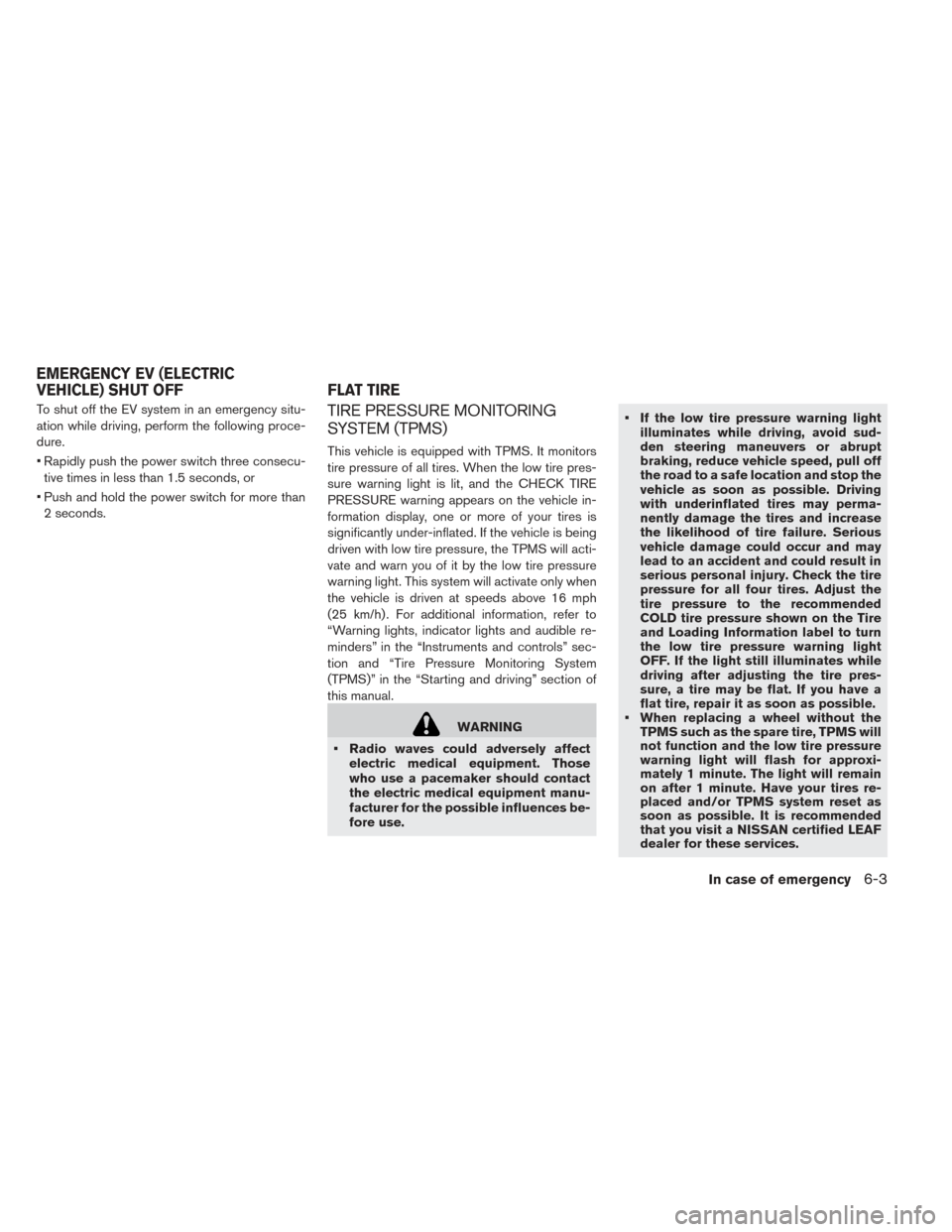
To shut off the EV system in an emergency situ-
ation while driving, perform the following proce-
dure.
• Rapidly push the power switch three consecu-tive times in less than 1.5 seconds, or
• Push and hold the power switch for more than 2 seconds.TIRE PRESSURE MONITORING
SYSTEM (TPMS)
This vehicle is equipped with TPMS. It monitors
tire pressure of all tires. When the low tire pres-
sure warning light is lit, and the CHECK TIRE
PRESSURE warning appears on the vehicle in-
formation display, one or more of your tires is
significantly under-inflated. If the vehicle is being
driven with low tire pressure, the TPMS will acti-
vate and warn you of it by the low tire pressure
warning light. This system will activate only when
the vehicle is driven at speeds above 16 mph
(25 km/h) . For additional information, refer to
“Warning lights, indicator lights and audible re-
minders” in the “Instruments and controls” sec-
tion and “Tire Pressure Monitoring System
(TPMS)” in the “Starting and driving” section of
this manual.
WARNING
• Radio waves could adversely affect electric medical equipment. Those
who use a pacemaker should contact
the electric medical equipment manu-
facturer for the possible influences be-
fore use. • If the low tire pressure warning light
illuminates while driving, avoid sud-
den steering maneuvers or abrupt
braking, reduce vehicle speed, pull off
the road to a safe location and stop the
vehicle as soon as possible. Driving
with underinflated tires may perma-
nently damage the tires and increase
the likelihood of tire failure. Serious
vehicle damage could occur and may
lead to an accident and could result in
serious personal injury. Check the tire
pressure for all four tires. Adjust the
tire pressure to the recommended
COLD tire pressure shown on the Tire
and Loading Information label to turn
the low tire pressure warning light
OFF. If the light still illuminates while
driving after adjusting the tire pres-
sure, a tire may be flat. If you have a
flat tire, repair it as soon as possible.
• When replacing a wheel without the TPMS such as the spare tire, TPMS will
not function and the low tire pressure
warning light will flash for approxi-
mately 1 minute. The light will remain
on after 1 minute. Have your tires re-
placed and/or TPMS system reset as
soon as possible. It is recommended
that you visit a NISSAN certified LEAF
dealer for these services.
EMERGENCY EV (ELECTRIC
VEHICLE) SHUT OFF FLAT TIRE
In case of emergency6-3